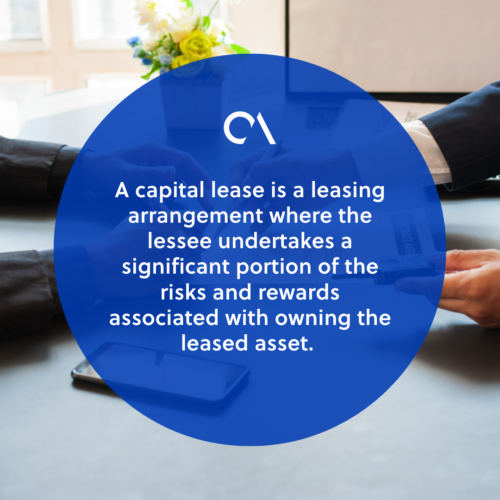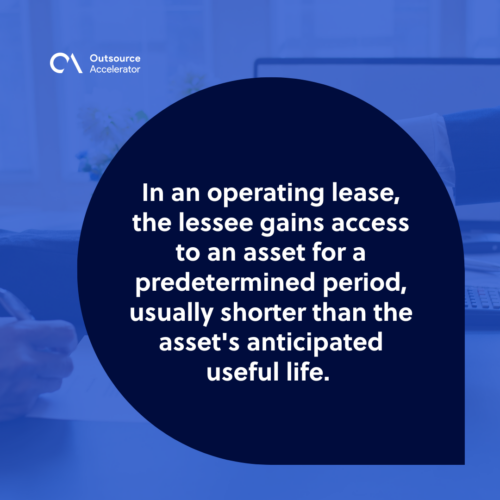Capital lease vs. Operating lease: Side-by-side comparison

Leasing has become a popular option for businesses to acquire assets without the full upfront cost, providing flexibility and financial advantages.
Two primary options stand out: capital lease and operating lease. The right type of leasing holds substantial importance for businesses due to its far-reaching financial implications.
The decision shapes how a business utilizes assets, directly impacting its cash flow, tax deductions, and overall flexibility.
This article explores Capital lease vs. Operating lease, including their distinct features, benefits, and drawbacks.
Defining capital lease
A capital lease is a leasing arrangement where the lessee undertakes a significant portion of the risks and rewards associated with owning the leased asset. The lessee can either be an individual or a business entity.
This type of lease is similar to purchase in accounting and financial reporting, as it effectively transfers the benefits and responsibilities of ownership to the lessee.
As a result, the leased asset is treated as if it were owned by the lessee for accounting and financial reporting purposes.

Characteristics of capital lease
A capital lease is more than just a simple rental agreement; it embodies a series of features that align it closely with asset ownership.
Here are the following characteristics of a capital lease:
Ownership transfer at the end of the lease term
This characteristic underscores the long-term commitment and investment-like nature of capital leases.
The lease agreement typically outlines the conditions under which ownership is transferred. It marks a strategic departure from other leasing arrangements where ownership remains vested with the lessor.
The transfer of ownership isn’t just a formality; it signifies a fundamental shift in the lessee’s relationship with the asset.
As a result of this transfer, the lessees are entitled to recognize the asset as their own on the balance sheet. This leads to potential enhancements in financial ratios and the lending capacity of the business.
Bargain purchase option
Embedded within many capital leases is a financial provision known as the bargain purchase option.
This facet extends the lessee a unique advantage: The opportunity to acquire the leased asset at a notably reduced price compared to its prevailing fair market value at the end of the lease term.
This option substantially strengthens the lessee’s standing as a potential future owner. The lease arrangement becomes increasingly appealing economically by offering the chance to purchase the asset at a bargain.
Longer lease term
Capital leases are characterized by their extended lease terms. This strategic decision to engage in a lengthier commitment often aligns with the nature of the leased asset’s useful life.
The concept of a longer lease term supports businesses aiming to secure the advantages of a capital lease over an extended duration. It particularly suits industries where the asset’s lifecycle exceeds the standard periods covered by operating leases.
Pros and cons of capital lease
Here are the pros and cons of the capital lease:
| Pros | Cons |
| Gain ownership of the asset at the end of lease | Adds to long-term liabilities |
| Enhances financial ratios | Requires detailed financial reporting |
| Claim depreciation deductions | Generally more expensive than operating leases upfront |
| Customize and use the asset as needed | Lessee is responsible for maintenance costs |
| Benefit from any appreciation of the asset | The asset might become outdated |
Defining operating lease
In an operating lease, the lessee gains access to an asset for a predetermined period, usually shorter than the asset’s anticipated useful life. This type of lease allows businesses to utilize assets for specific projects or needs without committing to long-term ownership.
In other words, an operating lease does not involve such ownership transfer. Instead, the lessor retains ownership and often provides options for the lessee to return, renew or upgrade the lease.

Characteristics of operating lease
Operating leases provide businesses flexibility and short-term asset access without entailing ownership responsibilities.
Here are the following characteristics of an operating lease:
No ownership transfer at lease end
Unlike capital leases, where the lessee gains ownership of the asset at the end of the lease term, operating leases maintain a distinct separation between lessee and ownership.
Instead of assuming ownership, the lessee is typically presented with multiple options as the lease term concludes.
No bargain purchase option
Operating leases are also distinct in their lack of a bargain purchase option, a feature commonly found in capital leases.
This feature suits the shorter-term nature of operating leases, where the primary objective is to utilize the asset for a specific duration rather than commit to long-term ownership.
Shorter lease term
Operating lease allows businesses to acquire assets for specific projects, short-term needs, or situations where asset turnover is frequent. This feature appeals to businesses engaged in seasonal operations or those with dynamic operational demands.
Pros and cons of operating lease
Here are the pros and cons of an operating lease:
| Pros | Cons |
| Can be easily upgraded to new assets | No asset ownership |
| Lower initial financial commitment | Cumulative costs might exceed purchasing |
| Lessors are often responsible for maintenance | No gains from asset value increase |
| Deduct lease payments as operating expenses | Limited customization options |
| Lesser risk of asset obsolescence | Cannot claim depreciation deductions |
Capital lease vs. Operating lease: Comparing differences
By examining the distinctive aspects between capital and operating leases, we can unravel how each lease type influences a company’s financial health.
| Capital lease vs. Operating lease: Key differences | ||
| General financial implications comparison | Capital lease | Operating lease |
| Accounting treatment and reporting | Registered as an asset and liability on the balance sheet | Only lease payments are recorded as expenses |
| Impact on the balance sheet and liability | Boosts both assets and liabilities on the balance sheet | Has a smaller impact on the balance sheet |
| Maintenance and risk responsibility | Lessee is responsible for maintenance and risk | Lessor often retains maintenance responsibility |
| Tax implications | Have depreciation benefits and interest expense tax deductions | Lease payments are tax-deductible operating expenses but don’t have depreciation benefits |
Capital lease vs. Operating lease: When to choose the right lease
Capital lease vs. Operating lease, what’s in it for you?
The choice between these two leases depends on various factors, such as the business’s financial goals, long-term plans, and the nature of the asset.
Opt for a capital lease when you:
- Intend to use the asset for its entire useful life
- Want ownership benefits
- Are prepared to manage the asset’s maintenance and related costs
Choose an operating lease when you need the flexibility to upgrade assets frequently but prefer to avoid ownership and long-term maintenance responsibilities.
Understanding each option’s key differences can help you make an informed choice that aligns with your organization’s objectives and resources.







 Independent
Independent




